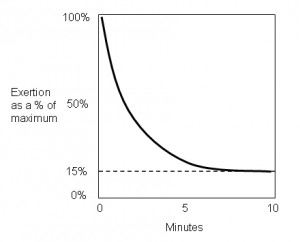Static load refers to sustained muscle contraction, such as the fatigue and pain of writer’s cramp from holding a pencil for a long period of time. Static load is especially stressful in combination with high force and awkward posture, but the primary concern is the duration of time that the muscles are contracted.
The classical perspective is the number of continuous minutes it takes before the onset of pain. More recently, with the concern for highly repetitive jobs, the approach taken has been to study the percentage of time in which a single muscle group is used.
The following guideline* has been established for continuous minutes before the onset of pain. No guidelines yet exist for percentage of time.

A muscle can be exerted at 100% of maximum for only a few moments before the onset of pain. As the percentage of maximum exertion is reduced, the muscle tension can be held for increasing lengths of time. For example, if a muscle is tensed to about 50% of maximum, it can be held for about 2 minutes.
At about 15% of maximum effort, the muscle tension can be held for extended periods. Consequently, for tasks that involved continuous effort, the force levels should be designed to be a maximum of 15% of maximum strength.
For example, the maximum force to hold a dead man’s switch with the full hand is 9 lbs.
Maximum hand grip exertion**:
– Average female 63 lbs.
– Average male 104 lbs.
15% of female grip = 9 lbs.
*This curve is often referred to as “Rohmert’s Curve” after Walter Rohmert, who published the original study of this type. Rohmert, W., 1968, in See also Chaffin, D.B., Andersson, G.B.J., and Martin, B., 2006. Occupational Biomechanics, 4th Edition. New York: John Wiley & Sons.
**Mathiowetz V., Kashman N., Volland G., Weber K., Dowe M. and Rogers S., 1985. Grip and Pinch Strength: Normative Data for Adults, Arch. Phys. Med. Rehabil. (Vol. 66).
